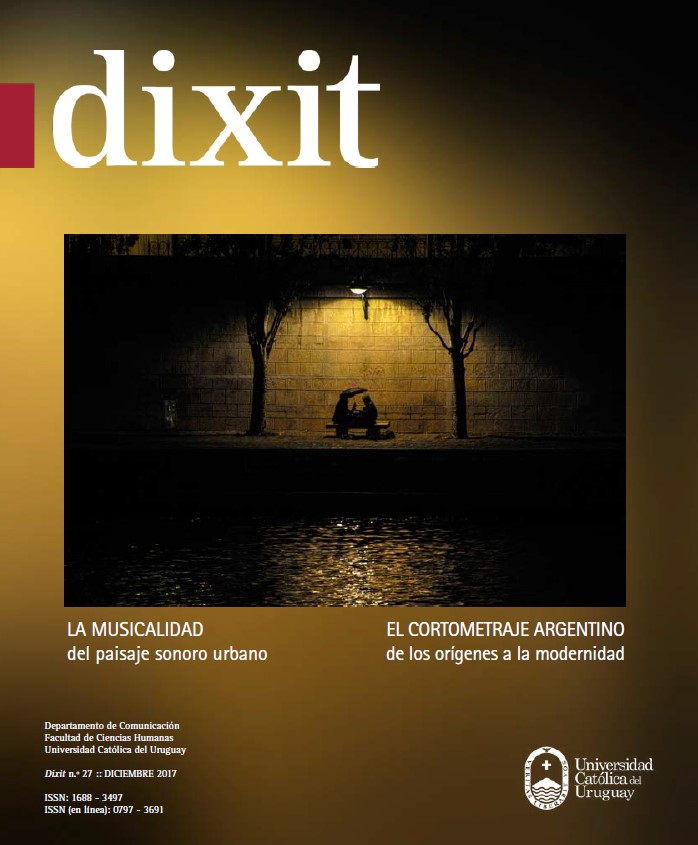The reception of Terry and the Pirates during World War II
DOI:
https://doi.org/10.22235/d.v0i27.1493Keywords:
Terry and the Pirates, Milton Caniff, World War II, reception studies, newspaper comicAbstract
This paper presents a study of the reception of the series of newspaper comics Terry and the Pirates by Milton Caniff. The perception of the events of World War II that the readers of the series had is analyzed. This is a pioneering study regarding the reception of newspaper comics, a medium of communication of great importance in the analyzed period, since the number of readers of the most successful series, such as the one that focuses this article, exceeded thirty million. The study is based on letters sent by readers to the author preserved at Ohio State University. This article shows the importance that the characters had for the readers, and the perception of the warfare conflict from the civil and military points of view.
Downloads
References
Bennet, T. y Woollacot, J. (1987). Bond and Beyond: The Political Career of a Popular Hero. Nueva York, NY: Methuen.
Brunner, E. (2006). Death and the Maiden: Milton Caniff’s Pre-War Anti-Elegiac War Elegy. International Journal of Comic Art, 8(1), 174-196.
Burke, P. (2001). Eyewitnessing. The Uses of Image as Historical Evidence.Islington, Reino Unido: Reaction Books.
Caniff, M. (1907-1988). Correspondencia. The Billy Ireland Cartoon Library and Museum (MAC.P278-MAC.P282). Ohio State University, Columbus, OH.
Caniff, M. (1946). The Comics. En J. Goodman (Coord.), While You Were Gone. A Report in War Life in the United States (pp. 488-510). Nueva York, NY: Simon and Schuster.
Caniff, M. (24 de abril de 1950). Dumas from Ohio. Newsweek, pp. 58-61.
Caniff, M. (noviembre de 1958). Don’t laugh at the comics. Cosmopolitan, pp. 43-47.
Caniff, M. (1978). Shop Talk. A Detour Guide for an Armchair Marco Polo. Cartoonews, 18, 29-31.
Caniff, M. (2012). Terry and The Pirates. San Diego, CA: IDW Publishing.
Capra, F. (Director). (1945). Why we Fight, War Comes to America. [Documental]. Estados Unidos: Sony Pictures Classics.
Coma, J. (1986). Cuando la inocencia murió. Madrid, España: Ediciones Eseuve.
De Jongh, E. (1999). The Iconological Approach to Seventeenth-Century Dutch Painting. En F. Grijnzenhoud y H. van Veen (Coords.), The Golden Edge of Dutch Painting in Historical Perspective (pp. 200-224). Cambridge, Reino Unido: Cambridge University Press.
Fornaroli, E. (1988). Milton Caniff. Un Filmico Pennello tra il Nero e il Merletto. Florencia, Italia: La Nova Italia.
Gardner, J. (2012). Projections: Comics and the History of Twenty-First Century Storytelling. Palo Alto, CA: Stanford University Press.
Gordon, D.M. (2006). The China-Japan War 1931-1945. The Journal of Military History, 70(1), 137-182.
Grandío, M. (2009). TV Entertainment. An Audience Study trough the Concept of “liking”. Communication & Society,22(2), 139-158.
Harvey, R.C. (2007). Meanwhile… Milton Caniff, a Biography. Seattle, WA: Fantagraphic Books.
Hayward, J.P. (1997). Consuming Pleasures: Active Audiences and Serial Fictions from Dickens to Soap Opera. Lexington, KY: University Press of Kentucky.
Hoffner, C., y Buchanan, M. (2005). Young Adults’ Wishful Identification With Television Characters: The Role of Perceived Similarity and Character Attributes. Media Psychology, 7(4), 325-351.
Igartua, J., y Muñiz, C. (2008). Identificación con los Personajes y Disfrute ante Largometrajes de Ficción. Una Investigación Empírica. Comunicación y Sociedad,21(1), 25-51.
Jensen, K.B. (1987). Qualitative Audience Research: Toward an Integrative Approach to Reception. Critical Studies in Mass Communication, 4(3), 21-36.
Mintz, L.E. (1979). Fantasy, Formula, Realism, and Propaganda in Milton Caniff's Comic Strips. Journal of Popular Culture,12(4), 653-680.
Morley, D. (2003). Television, Audiences and Cultural Studies. Nueva York, NY: Routledge.
Saez de Adana, F. (2014). Las Tiras de Prensa Norteamericanas de Finales del Siglo XIX y Principios del Siglo XX como Reflejo de la Sociedad. Revista Internacional de Historia de la Comunicación, 3(1), 20-47.
Terkel, S. (1984). The Good War. An Oral History of World War II. Nueva York, NY: The New Press.
Yronwode, C. (1984). La Segunda Guerra Mundial y los Cómics. En J. Coma (Coord.), Historia de los Cómics, vol. 1 (pp. 217-224). Barcelona, España: Toutain.
Tulloch, J., y Jenkins, H. (1995). Science Fiction Audiences. Londres, Reino Unido: Routledge.
Downloads
Published
How to Cite
Issue
Section
License
From issue number 32 onwards all contents are licensed under the Creative Commons Attribution 4.0 International License (CC BY 4.0).
Issues number 29-31 are licensed under the Creative Commons Attribution-NonCommercial 4.0 International License.
The contents corresponding to number 28 and earlier editions are under the Creative Commons Attribution-NonCommercial-ShareAlike 4.0 International License.


















